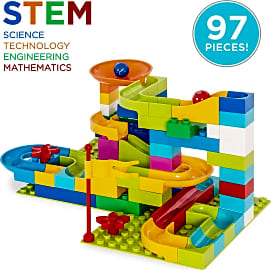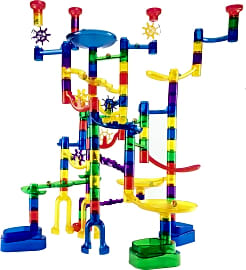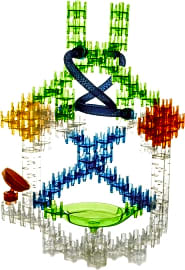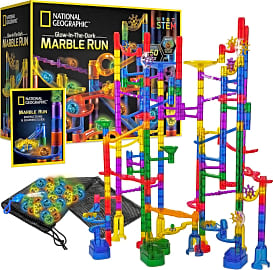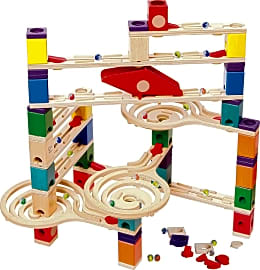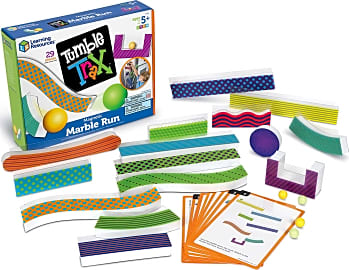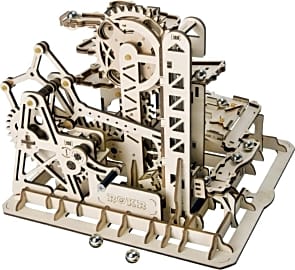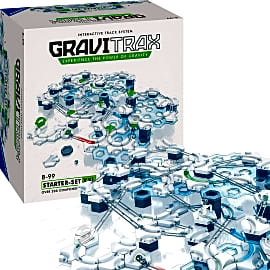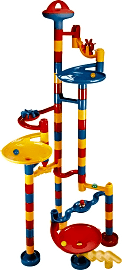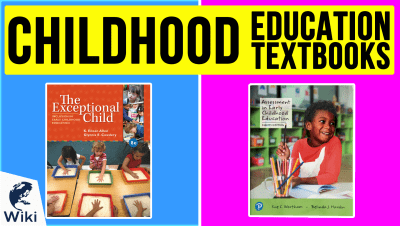The 10 Best Marble Runs

This wiki has been updated 45 times since it was first published in September of 2015. Not all the best toys need batteries or come with a screen. A marble run, sometimes called a kugelbahn, will keep your kids amused for hours while, unbeknownst to them, they are developing important skills such as hand-eye coordination, spatial and design abilities, angle recognition, and problem solving. Just make sure to supervise them, as marbles can be a choking hazard for young children. When users buy our independently chosen editorial choices, we may earn commissions to help fund the Wiki.
Editor's Notes
October 22, 2020:
In our latest update, we've tried to make sure our list includes playsets that suit a broad range of ages and interests. We added the Ravensburger GraviTrax XXL, a highly modular set that offers hours of experimentation for older kids, and the Rowood Tower Coaster LG504, which will engage those who enjoy model-building and puzzle assembly. We also replaced the Galt Toys Super, a fairly generic marble run, with the Galt Toys Racer, a very similar item that includes more pieces and allows for multi-person competitions.
We got rid of the Discovery Toys Marbleworks Starter Set, which in our opinion doesn't offer enough variety or versatility for its price tag; the less expensive Marble Genius Super Set includes nearly twice as many pieces. We also removed the ThinkFun Gravity Maze, which we felt was an interesting concept that didn't quite nail the execution. It makes for a solid logic puzzle game, but the included towers are fixed rather than being made of modular pieces, which limits the ability of users to create their own fun configurations.
Our final new addition is the National Geographic Glow in the Dark, which offers the amusing twist of glowing glass marbles, as well as a pretty substantial variety of see-through track-building pieces. In addition to its entertainment value, it comes with an educational guide that helps kids use their toy to explore the principles of kinetics and aerodynamics.
We provide reviews of numerous other educational games and gifts, like creative building sets or programmable robots. And for teachers, parents, and other interested individuals, we've compiled a list of the best books about helping children learn.
November 09, 2019:
At this time, we have looked for a wide variety of marble runs to engage children both younger and older. Just remember that young kids require ample supervision, as marbles and small parts can be a choking hazard.
When it comes to a blend of durable pieces and potential for fun, options from MindWare, including the MindWare Mega and MindWare Q-Ba-Maze 2.0 are popular choices. The latter is better for older kids with more patience, hand-eye coordination, and spatial reasoning, much like the Quercetti Skyrail, an entertaining — if somewhat complex — science toy. At the other end of the difficulty spectrum, we've selected the Learning Resources Tumble Trax. It sticks to magnetic surfaces and so doesn't require connections and balancing. We decided to add one Duplo-compatible option, too, the Best Choice Products 97-Piece. Granted, at 97 pieces, it's not as large as many; however, since it works with the blocks already found in many homes, it represents a good value.
Finally, whereas most marble runs are plastic, the Hape Quadrilla Vertigo is mostly made from wood, which is welcome news for some parents. A cheery, colorful model, it is good for parent/child collaboration. But we have removed the Hape Quadrilla Twist and Rail, as it has become difficult to find at this time.
Special Honors
Xyloba Orchestra The Xyloba Orchestra goes one step further than most and integrates sound modules, allowing kids to compose melodies as they build. It's best for kindergarten-aged children and older, and you can count on it for years of fun, as the set is made to exacting quality standards in Switzerland. shopxyloba.com
Choosing Toys That Challenge And Amuse
Blocks require proper associations of shapes and necessitate spatial reasoning, and may incorporate colors, numbers, and letters.
Since every child wants to be engaged and challenged, playtime with the right orchestration by a parent or caregiver can be an opportunity to learn and grow, both cognitively and physiologically. It will benefit a youngster well beyond the time he or she cleans up the toys and moves on to the next activity.
For younger children, especially those in their toddler years, play is not just one way to help foster these skills - it's the ideal way. The importance of play cannot be stated unequivocally enough, and in fact no less of a body than the United Nations High Commission for Human Rights has noted that play should be a right for every child the world over.
The right objects and activities can help children at play develop capacities including dexterity, emotional fortitude, cooperation skills, and patience. On the other hand, having fun in a stress-free environment, in which they can feel as though they are in control of themselves and their activities, aids kids in developing self-confidence and problem-solving skills that will serve them throughout their lives.
The ideal playtime session involves choices facilitated by an adult caregiver or educator, but which feels like an experience of open opportunity. A child offered two or three options for toys or activities rather than just one will feel as though he or she is empowered to make a choice, while in practice the adult has directed the play activity by limiting the number of options. On the other pole, offering too many play options can overwhelm a young mind, making it difficult for them to successfully make any choice and ultimately serving to be counterproductive.
When selecting toys for encouraging a productive, engaging playtime, consider those that operate on several cognitive levels. Blocks require proper associations of shapes and necessitate spatial reasoning, and may incorporate colors, numbers, and letters. Puzzles involve shapes and images (and even artwork). And once a child is ready for toys that involve design and construction -- toys that require planning and predictions prior to use, e.g. -- they are entering a whole new level of exciting and challenging play.
Choosing The Best Marble Run For Your Youngster
A marble run is an ideal toy for many inquisitive youngsters. Marble runs involve careful planning prior to execution, with a child required to think through the path a marble might take, a design and appearance he or she will enjoy, and a structure that will stand up on its own and allow a marble to roll smoothly along on its way.
A set falling into the former category can be enjoyed by kids well into their elementary years thanks to their potential for ever more elaborate, challenging designs.
Marble runs vary in complexity, with some involving oddities like elevators and loops. Other options simply create a winding path to the bottom to let children observe gravity in action. A set falling into the former category can be enjoyed by kids well into their elementary years thanks to their potential for ever more elaborate, challenging designs. However, such an option may confuse and confound a younger child, frustrating them rather than encouraging enjoyable exploration.
Simpler sets may absorb a toddler for hours as he or she engages with their marble run using trial and error experimentation, honing those critical thinking and planning skills. But of course a set too simple for an older child (or a toddler of sharp intellect) will quickly become an elaborate paper weight.
When in doubt, choose a marble run that might be slightly advanced for your child or student; you can always put it away for a few months and try again later. And also consider only offering some of the pieces initially. A child can grow comfortable with the planning and construction involved with a marble run using part of the set, and then enjoy adding more and more components over time.
Be sure to keep in mind that marble runs contain many pieces, including the marbles themselves, that present a choking hazard for small children. Adult supervision is needed if there is any chance of a child putting small objects in their mouth.
Integrating A Marble Run Into Learning
Beyond the critical thinking skills and the physical mechanics that are inherent in playing with a marble run, these classic toys offer myriad other opportunities for learning and exploration. A parent or caregiver can integrate something as simple as counting skills into marble run play, asking a child to choose and use a certain number of marbles at a time, or to count each one as it starts down its course.
Marble runs also allow for easy practice with colors, though the purchase of additional marbles might be required.
Marble runs also allow for easy practice with colors, though the purchase of additional marbles might be required. Marble runs can also help a child practice creating patterns, by sending a specified arrangement of marble colors or types down the run in the right order.
As a child grows and learns, a marble run can even be used to start understanding physical forces like gravity and centrifugal force (or centripetal force for the truly advanced child), and he or she can try integrating their marble run into other systems. They might link their track with a set of dominoes, or control some aspects of the marble run with simple machines or electronics.


